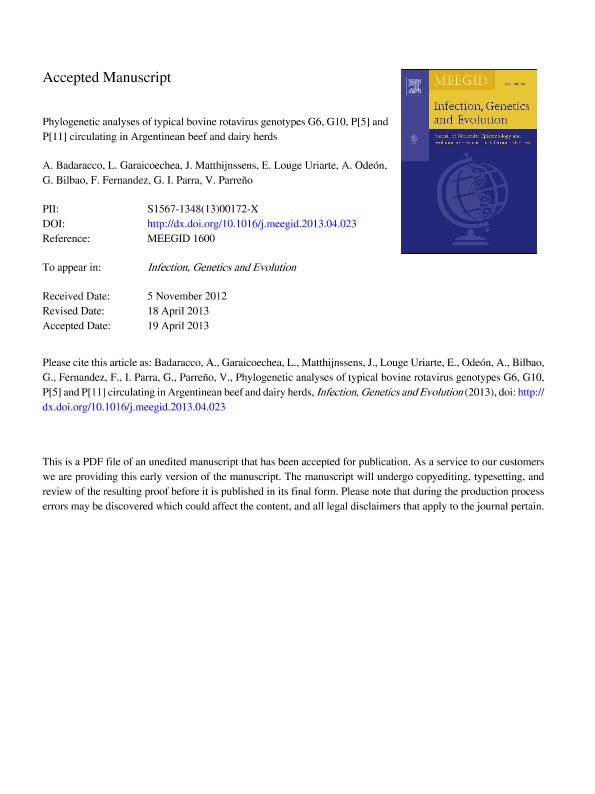Artículo
Phylogenetic analyses of typical bovine rotavirus genotypes G6, G10, P[5] and P[11] circulating in Argentinean beef and dairy herds
Badaracco, Alejandra ; Garaicoechea, Lorena Laura
; Garaicoechea, Lorena Laura ; Matthijnssens, J.; Louge Uriarte, Enrique Leopoldo
; Matthijnssens, J.; Louge Uriarte, Enrique Leopoldo ; Odeón, Anselmo Carlos; Bilbao, Gladys Noemí; Fernandez, Fernando; Parra, G. I.; Parreño, Gladys Viviana
; Odeón, Anselmo Carlos; Bilbao, Gladys Noemí; Fernandez, Fernando; Parra, G. I.; Parreño, Gladys Viviana
 ; Garaicoechea, Lorena Laura
; Garaicoechea, Lorena Laura ; Matthijnssens, J.; Louge Uriarte, Enrique Leopoldo
; Matthijnssens, J.; Louge Uriarte, Enrique Leopoldo ; Odeón, Anselmo Carlos; Bilbao, Gladys Noemí; Fernandez, Fernando; Parra, G. I.; Parreño, Gladys Viviana
; Odeón, Anselmo Carlos; Bilbao, Gladys Noemí; Fernandez, Fernando; Parra, G. I.; Parreño, Gladys Viviana
Fecha de publicación:
04/2013
Editorial:
Elsevier
Revista:
Infection, Genetics and Evolution
ISSN:
1567-1348
Idioma:
Inglés
Tipo de recurso:
Artículo publicado
Clasificación temática:
Resumen
Group A rotavirus (RVA) is one of the main causes of neonatal calf diarrhea worldwide. RVA strains affecting Argentinean cattle mainly possess combinations of the G6, G10, P[5] and P[11] genotypes. To determine RVA diversity among Argentinean cattle, representative bovine RVA strains detected in diarrheic calves were selected from a survey conducted during 1997–2009. The survey covered the main livestock regions of the country from dairy and beef herds. Different phylogenetic approaches were used to investigate the genetic evolution of RVA strains belonging to the prevalent genotypes. The nucleotide phylogenetic tree showed that all genotypes studied could be divided into several lineages. Argentinean bovine RVA strains were distributed across multiple lineages and most of them were distinct from the lineage containing the vaccine strains. Only the aminoacid phylogenetic tree of G6 RVA strains maintained the same lineages as observed at the nucleotide level, whereas a different clustering pattern was observed for the aminoacid phylogenetic trees of G10, P[5] and P[11] suggesting that the strains are more closely related at the aminoacid level than G6 strains. Association between P[5] and G6(IV), prevalent in beef herd, and between P[11] and G6(III) or G10 (VI and V), prevalent in dairy herds, were found. In addition, Argentinean G6(III), G10, P[5] and P[11] bovine RVA strains grouped together with human strains, highlighting their potential for zoonotic transmission. Phylogenetic studies of RVA circulating in animals raised for consumption and in close contact with humans, such as cattle, contribute to a better understanding of the epidemiology of the RVA infection and evolution.
Palabras clave:
Bovine
,
Diarrhea
,
Phylogeny
,
Rotavirus
,
Typing
Archivos asociados
Licencia
Identificadores
Colecciones
Articulos(SEDE CENTRAL)
Articulos de SEDE CENTRAL
Articulos de SEDE CENTRAL
Citación
Badaracco, Alejandra; Garaicoechea, Lorena Laura; Matthijnssens, J.; Louge Uriarte, Enrique Leopoldo; Odeón, Anselmo Carlos; et al.; Phylogenetic analyses of typical bovine rotavirus genotypes G6, G10, P[5] and P[11] circulating in Argentinean beef and dairy herds; Elsevier; Infection, Genetics and Evolution; 18; 4-2013; 18-30
Compartir
Altmétricas



